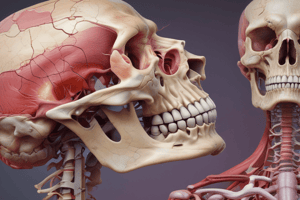Podcast
Questions and Answers
Which symptom is most commonly associated with a giant cell tumor of bone?
Which symptom is most commonly associated with a giant cell tumor of bone?
- Pathologic fractures
- Localized swelling (correct)
- Spinal neurological deficits
- Nerve impingement pain
What is a characteristic radiological finding of an aneurysmal bone cyst?
What is a characteristic radiological finding of an aneurysmal bone cyst?
- Soap bubble appearance (correct)
- Dark radiolucent area with a central sclerotic dot
- Expansile lytic lesion with surrounding sclerosis
- Mottled, osteolytic lesion with sunburst reaction
What best describes a fibrous cortical defect?
What best describes a fibrous cortical defect?
- Symptomatic and requires aggressive treatment
- Rare and typically located in the axial skeleton
- Malignant bone tumor
- A developmental defect commonly found in teenagers (correct)
What type of bone tumor is most frequently associated with Paget disease?
What type of bone tumor is most frequently associated with Paget disease?
Which characteristic is indicative of a giant cell tumor of bone on histopathological examination?
Which characteristic is indicative of a giant cell tumor of bone on histopathological examination?
What radiological finding is typically associated with an aneurysmal bone cyst?
What radiological finding is typically associated with an aneurysmal bone cyst?
Which condition is often asymptomatic and found incidentally in adolescents?
Which condition is often asymptomatic and found incidentally in adolescents?
A giant cell tumor of bone primarily affects which demographic?
A giant cell tumor of bone primarily affects which demographic?
What is the primary treatment method for fibrous cortical defects?
What is the primary treatment method for fibrous cortical defects?
Which imaging characteristic is highly suggestive of a giant cell tumor of bone?
Which imaging characteristic is highly suggestive of a giant cell tumor of bone?
What may indicate a more aggressive nature of bone tumors diagnosed via imaging?
What may indicate a more aggressive nature of bone tumors diagnosed via imaging?
How do aneurysmal bone cysts typically present radiologically?
How do aneurysmal bone cysts typically present radiologically?
The presence of which feature is common in the pathologic examination of a giant cell tumor?
The presence of which feature is common in the pathologic examination of a giant cell tumor?
What sort of bone tumors would typically show a ‘soap bubble’ appearance in imaging?
What sort of bone tumors would typically show a ‘soap bubble’ appearance in imaging?
Which of the following is a characteristic feature of Giant Cell Tumor of Bone?
Which of the following is a characteristic feature of Giant Cell Tumor of Bone?
What is a common radiological finding associated with Aneurysmal Bone Cyst?
What is a common radiological finding associated with Aneurysmal Bone Cyst?
Which statement best describes Fibrous Cortical Defect?
Which statement best describes Fibrous Cortical Defect?
Paget Disease of Bone is commonly associated with which of the following?
Paget Disease of Bone is commonly associated with which of the following?
Which radiological finding is often observed in bone tumors?
Which radiological finding is often observed in bone tumors?
Which histological feature is typically associated with Giant Cell Tumor of Bone?
Which histological feature is typically associated with Giant Cell Tumor of Bone?
What is a common outcome of untreated Paget Disease of Bone?
What is a common outcome of untreated Paget Disease of Bone?
A radiological finding typical for a chondrosarcoma would include:
A radiological finding typical for a chondrosarcoma would include:
Flashcards are hidden until you start studying
Study Notes
Tumor Pathogenesis and Presentation
- Tumors can be benign or malignant, with variations in pathogenesis and clinical presentation.
- Benign bone and cartilage-forming tumors often present with distinct radiologic and histologic features.
Classification of Tumors
- Important types include osteosarcoma, chondrosarcoma, Ewing sarcoma, and giant cell tumor of bone.
- Each type exhibits unique pathogenesis, clinical signs, radiologic findings, treatment options, and prognosis.
Metastatic Tumors
- Common metastatic tumors to bone often originate from primary cancers such as breast, prostate, and lung.
- These tumors may exhibit characteristic features that differentiate them from primary bone tumors.
Joint Tumors and Tumor-like Lesions
- Joints can also be affected by various tumors and tumor-like lesions, requiring proper identification for treatment.
Bone Structure
- Epiphysis located between the growth plate and the end of the bone, significant for growth and joint function.
- Metaphysis lies between the growth plate and diaphysis, a critical region for tumor development.
- Diaphysis, or shaft, predominantly composed of compact cortical bone, serves structural support.
Histological Characteristics
- Low power microscopy reveals a network of irregularly shaped sheets and spikes of bone (trabeculae).
- Histological examination at high power identifies key cell types including osteoblasts (bone formation) and osteoclasts (bone resorption).### Overview of Bone Tumors
- Most frequent bone tumors are metastatic malignancies; primary bone tumors are predominantly benign.
- Essential factors for diagnosis: patient age, affected bone, area of involvement, and radiologic appearance.
- Clinical symptoms are generally insufficient for definitive diagnosis.
- Radiologic studies play a crucial role in assessing tumor location and aggressiveness.
Classification of Bone Tumors
- Hematopoietic: Includes myeloma and lymphoma.
- Bone forming: Comprises osteoid osteoma, osteoblastoma, and osteosarcoma.
- Cartilage forming: Encompasses osteochondroma, chondroma, chondroblastoma, chondromyxoid fibroma, and chondrosarcoma.
- Unknown origin: Contains giant cell tumor, aneurysmal bone cyst, Ewing sarcoma, and adamantinoma.
- Notochordal: Includes chordoma.
Osteoid Osteoma
- Benign tumor, less than 1.5 cm, most common in males aged 5-24 years.
- Predominantly located in long bones, especially femur and tibia.
- Associated with nocturnal pain relieved by NSAIDs; linked to prostaglandin E2.
- Characteristic radiologic appearance: radiolucent lesion with bony sclerosis and central sclerotic dot.
- Treatment typically involves excision.
Osteoblastoma
- Also known as giant osteoid osteoma, typically larger than 2 cm; more common in females around age 20.
- Frequently found in the spine and sacrum with progressive pain, unresponsive to NSAIDs.
- May lead to neurological symptoms or scoliosis due to spinal involvement.
- Similar histological features to osteoid osteoma.
- Treatment options include curettage and en bloc resection.
Osteosarcoma
- Malignant bone tumor originating osteoid directly from tumor cells; second most common primary bone tumor after myeloma.
- Affects primarily men aged 10-25; older cases often linked to Paget disease or prior radiation.
- Commonly arises in the metaphysis of long bones, particularly around the knee.
- Presents with localized pain; multifocal varieties often seen in children.
Radiologic and Pathologic Features of Osteosarcoma
- Radiologically appears as a large, destructive, lytic or blastic mass with permeative margins, potentially breaching cortex and elevating periosteum.
- Key pathologic features include a high-grade tumor with irregular bone formation and an osteoid matrix.
Osteochondroma
- The most prevalent benign bone tumor, primarily affects males under 20.
- Typically found on the metaphysis, especially distal femur and proximal tibia; can be solitary or multiple.
- Causes pain when impinging on nerves; growth ceases around puberty.
- Risk of transformation into chondrosarcoma; treated via excision.
Chondrosarcoma
- Malignant tumors composed entirely of cartilaginous matrix; third most common primary bone malignancy.
- Most commonly occurs in the axial skeleton, particularly in males over 40 years of age.
- Characteristic aching pain, especially at night; classified into conventional and variant types.
- Radiologically destructive and expansile with visible calcifications.
Ewing's Sarcoma
- A variant of Ewing sarcoma family tumors; primarily affects children; originates in long bones or flat bones.
- Associated with EWSR1 gene fusion translocation; results in small, uniform cells with specific staining markers.
- Radiologic findings include mottled osteolytic lesions with characteristic periosteal reactions.
- Treatment encompasses chemotherapy, surgery, and radiation with a reasonable survival rate.
Giant Cell Tumor of Bone
- Known as osteoclastoma, categorized as benign yet locally aggressive; characterized by multinucleated giant cells.
- Commonly impacts individuals aged 20-40, notably in the knee region.
- Treatment usually involves surgical excision and may require adjunct radiation therapy if needed.
Aneurysmal Bone Cyst
- A rare osteolytic lesion filled with blood; occurs predominantly in individuals aged 1-20.
- Associated with localized pain and swelling; typically found in long bones' metaphysis.
- Rapid growth necessitates aggressive curettage or complete excision.
Fibrous Cortical Defect/Nonossifying Fibroma
- A developmental defect predominantly found in teenagers, benign and often asymptomatic.
- Lesions generally resolve spontaneously, typically appearing in the metaphysis of long bones.
- Management may involve observation or surgical intervention if symptomatic.
Fibrous Dysplasia
- A developmental lesion characterized by abnormal bone growth due to mutations affecting bone maturation.
- Commonly affects craniofacial bones and long bones; treated conservatively unless symptomatic or deformities arise.
Metastatic Bone Tumors
- The most prevalent malignant lesions in bone, often stemming from prostate, breast, kidney, and lung cancers in adults.
- In children, may originate from neuroblastoma, Wilms tumor, osteosarcoma, and others.
- Radiologic features vary between blastic and lytic lesions depending on the primary tumor type.
Tumors or Tumor-like Lesions of Joints
- Ganglion Cysts: Small cyst-like masses resulting from synovial fluid; may require surgical removal.
- Tenosynovial Giant Cell Tumor: Benign but aggressive tumors often treated surgically; characterized by proliferating histiocytes and multinuclear giant cells.
Studying That Suits You
Use AI to generate personalized quizzes and flashcards to suit your learning preferences.




